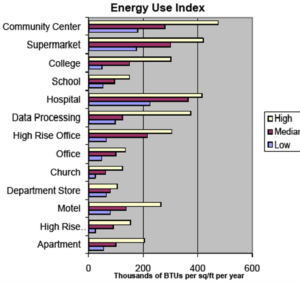The cost to build a duplicate facility in its best condition
Asset Current Replacement Value (CRV) is the total amount of expenditure required to construct a replacement facility to the current building codes, design criteria, and materials. The CRV for a single Asset can be based on the sum of the System replacement costs, or it can be a custom cost. The CRV may include or exclude overhead costs.
Priority One : Immediate Concerns:
Should be undertaken immediately including violations of life safety, building and electric codes. This also includes systems that have failed and are causing additional deterioration
Priority Two : Short Term Concerns ( 1 ‐ 2 years)
Should be corrected in the near future to maintain the integrity of the building, including systems that are functioning improperly or not at all and problems that, if not addressed, will cause additional deterioration.
Priority Three : Long Term Concerns ( 3 ‐ 5 years)
Should be corrected in the more distant future to maintain the integrity of the building, including systems that have exceeded their expected useful life but are still functioning.
Priority Four: Improvements
Required or desirable to allow the facility to perform as it should, including systems upgrades and aesthetic issues.
Priority Five: Does Not Meet Current Codes/Standards
Do not conform to codes instituted since the construction of the building and therefore grandfathered in their existing condition. These should be addressed in any major renovation or remodeling effort, if not before, and typically relate to accessibility code.
A part of a building
A System is an assembly, finish, fixture, piece of equipment, or other component that makes up
an Asset.All recommended improvements
The Requirements Index (RI) is a total needs Requirements index. RI includes the costs of all non‐closed Requirements, regardless of category and time. To determine RI for any given Asset, the total cost of addressing all Requirements is divided by the current replacement value. Requirements are prioritized; however, the RI includes everything that needs to be fixed. If you have a long list of requirements, this indicates that the building is in very poor physical condition and it not functioning well.
A needed improvement
A Requirement is a facility need or a deficient condition that should be addressed – basically, a requirement is a specific problem with a facility that needs to be fixed. Requirements include deferred maintenance, code issues, functional requirements, and capital improvements. A Requirement can affect an assembly, piece of equipment, or any other System. It is assigned a Category, Priority, and System in order for its costs to be categorized appropriately and time frame for action assigned. Example Requirements are as follows:

The cost of associated with postponing needed improvements
Deferred Maintenance is work that is deferred/ postponed on a planned or unplanned basis. Deferred maintenance includes existing major repairs and replacements; it does not include future maintenance, capital improvements or grandfathered code issues. Deferred Maintenance can be very costly.
A plan to fix a problem
An Action is a strategy for correcting a Requirement (a needed improvement) that includes the scope of work to be done and an itemized estimate of its cost.
The energy status and rank
The Energy Use Intensity (EUI) [kBut/sq ft/ year] is calculated by taking the total energy
consumed in one year (measured in kBtu) and dividing it by the total floorspace of the building.
For example, if a 50,000‐square‐foot school consumed 7,500,000 kBtu of energy last year, its EUI
would be 150. A similarly sized school that consumed 9,000,000 kBtu of energy last year would
have a higher EUI (180) to reflect its higher energy use. Generally, a low EUI signifies good energy
performance.What does EUI signify?
EUI allows you to quickly compare the energy use against a portfolio. Below are average EUIs, per building type, that have been collected and qualified by the Commercial Buildings Energy Consumption Survey (CBECS) - statistical models are used when gaps in CBECS data exists.
Unfortunately, not all building types have a standardized set of EUIs to use as a benchmark. Thus, it is important to note that the most useful way to evaluate a building’s energy performance is to compare that building’s EUI against itself to observe how that specific building’s EUI has changed over time.
Building Type Average EUI1 Dormitory 151 Hospital 468 Hotel 228 K-12 School 169 Medical Office Building 134 Office Building 193 1EUI values are presented in kBtu/ft2

Indicates when a system (part of the building) needs to be replaced
System Renewal is the cyclical repair and/or replacement of a System as it reaches or exceeds its
useful life. System Renewal is forecast to occur at the end of a System's lifetime in its Renewal
Year, which is based on the System's expected lifetime or its observed condition. The future costs
of System Renewal are based on the System Replacement Cost, and take in account the
percentage of the System that is renewed (% Renew). System Renewal costs are forecast in the
Renewal Forecast (a Funding Module report) as well as various System reports.A number that signifies how the building is holding up
Facility Condition Index (FCI) is an industry‐standard metric that objectively measures the current condition of a facility. The FCI is the % of investment (compared to the cost of replacing the facility entirely) that it will take to repair the facility to a like new condition within five years.
What does FCI signify?
FCI allows you to quickly compare the condition of assets against an industry‐wide standard or
across a portfolio.
